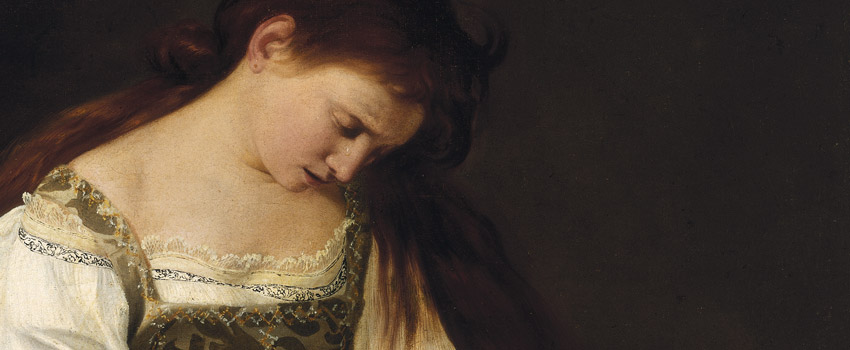
Yesterday I went on a mission to find a teardrop. The teardrop of Anna Bianchini. I didn’t have to go very far, I have been working in the same building — Rome’s Palazzo Doria Pamphilj — with that teardrop for the past 20 years and only recently learned of it. So yesterday I was determined to find it. I slipped out of the Associated Press Rome office at Piazza Grazioli 5 scurried down the sidewalk in the blistering heat and popped into the door of the Caffe’ Doria (See Elizabeth Minchilli’s Post – Caffe’ Doria). My friends, the waiters there, allowed me to slip through the back passageway that took me around the courtyard with orange trees and into the famous Doria Pamphilj Gallery.
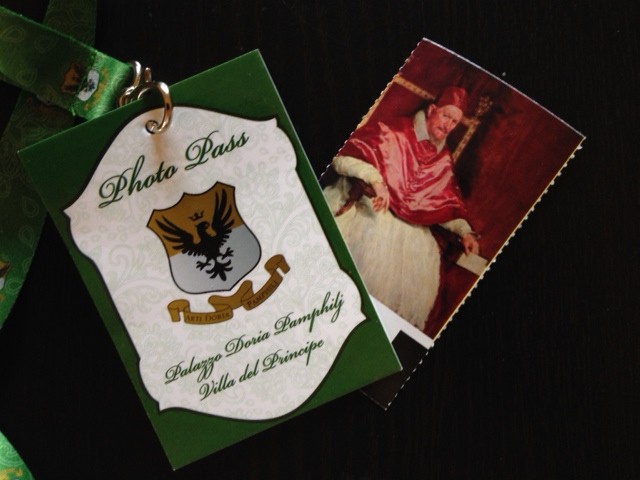
After buying my ticket and a convenient photo pass for taking pictures (I needed to take a picture of the teardrop), I briskly walked down the elaborate corridors with gilded frames holding paintings by such greats as Raphael, Titian, Caravaggio, Velasquez, Brueghel, Bernini, Domenichino and Guercino, past marble statues, elaborate chandeliers and large mirrors, until I found the room I was looking for, the Sala Aldrobrandini — with its line-up of three Caravaggio’s “The Penitent Magdalene”, “Rest on the Flight to Egypt” and “Saint John the Baptist.”
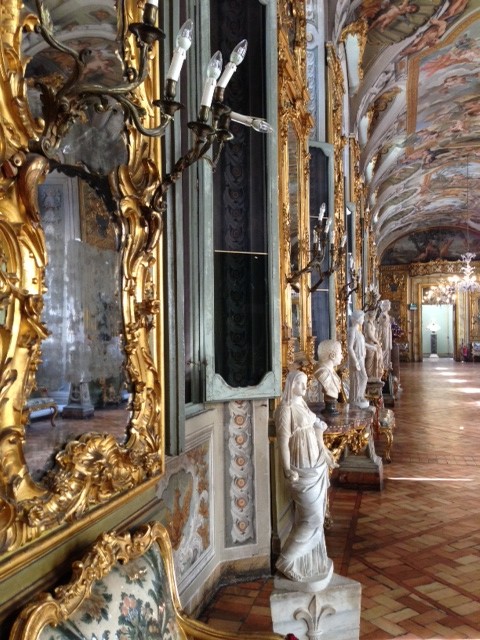
Now where was that tear drop and why was it interesting to me? Since I have started this blog I have often written about the mix of art, history and women figures in Rome (see Blog Posts: Artemisia Gentileschi- An Italian Heroine, Spooked and Inspired by Beatrice, Love and Passion in Rome, Caravaggio’s Women)
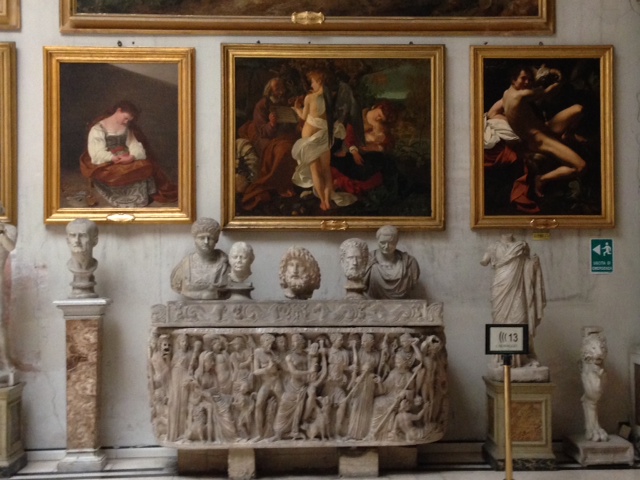
Recently, while taking the “Courtesans of Rome” tour, (see blog post: Rome- Simmering with Sensuality for Centuries) I learned from our guide Massimo De Fillippis of the story of Anna Bianchini and wanted to know more.
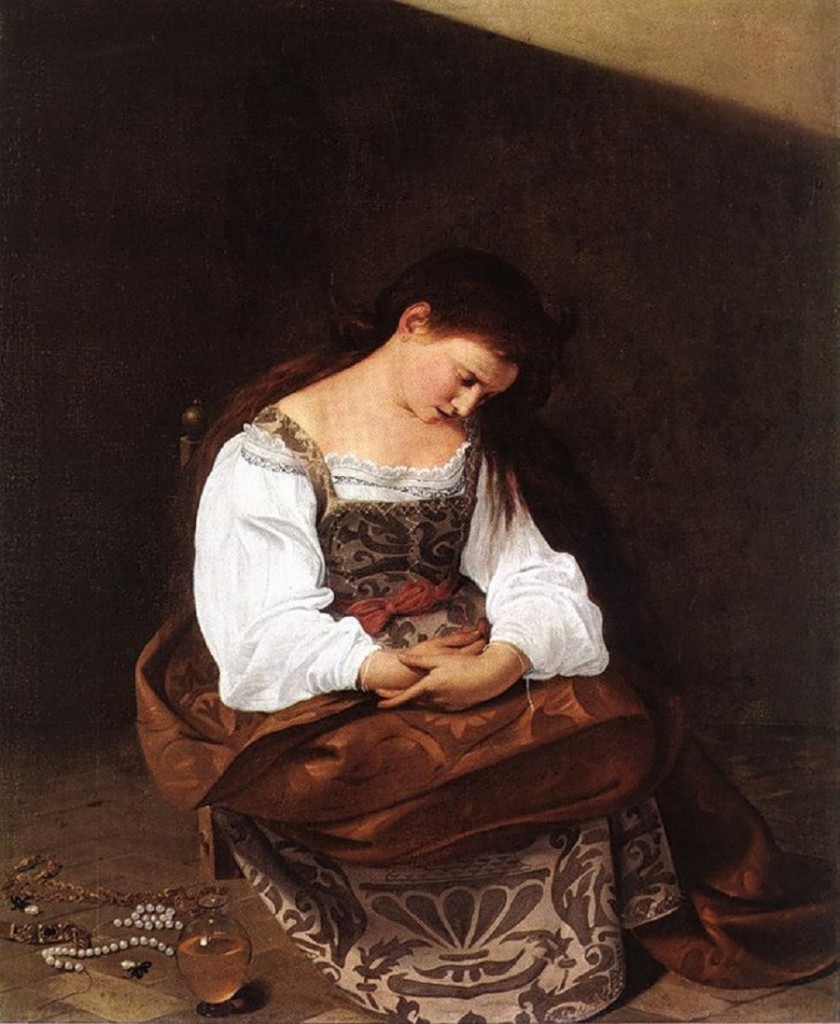
Reading through articles by art historians (In particular art historian Rossella Vodret, an Italian expert on Caravaggio) and art blogs, I learned that Anna Bianchini was the daughter of a prostitute from Tuscany who became a prostitute herself in Rome at age 12. She had long, wavy red hair and porcelain skin. Her delicate exterior was apparently in contrast with her rough lifestyle and lively character. She was not among the city’s high-class courtesans who lead lives of luxury through romantic attachments to noblemen and Cardinals. Instead Annuccia (little Anna) as she was called, and some of her prostitute friends mixed in a rough crowd of gamblers, gypsies, street urchins and artists. Their hangout was the Osteria Turchetto, in the center of Rome, where Annuccia was apparently picked up by police a couple of times for bar-fights and scuffles with other prostitutes and male pretenders. One police report quoted by Rossella Vodret referred to her as the “one with the long, red hair.” Part of that group included the artist Caravaggio. Caravaggio apparently used Anna Bianchini in four of his paintings. The one that interested me most was “The Penitent Magdalene.” In this painting, done by Caravaggio in 1597, the Penitent Mary Magdalene is sitting on a low chair in a dark room. She is dressed in Renaissance period clothing. There is a glass with some sort of liquid ointment in it, a broken string of pearls, an earring and some coins on the floor. The room is dark with just a shaft of light on her and in the upper right hand corner. Yesterday, pacing in front of the the painting, moving around the busts below it, and trying to see around the reflection, I finally saw what I had come for– the small pearl-like teardrop on the side of her nose.
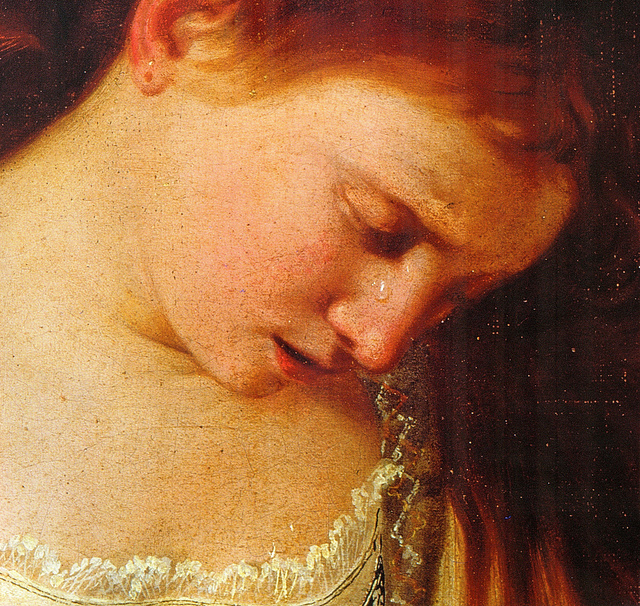
Why is Anna Bianchini crying? Apparently in that period Pope Clement VIII (1592-1605) had violent methods for imposing morality on Rome. Courtesans were acceptable, but prostitutes were not, and in order to teach a lesson to the people of Rome, he would have prostitutes stripped to the waist, whipped, thrown with their back exposed over the back of a donkey and paraded around the city. This is apparently what happened to Anna Bianchini before she sat down to be painted by Caravaggio as his model for “The Penitent Magdalene”, hence the sadness, the weary expression and the tear. This is typical of the rebellious Caravaggio, a trouble-maker and rabble-rouser, who poured his passion for life into his depictions of biblical stories, using realistic scenes and characters straight off the streets of Rome. Anna’s hands are swollen, she is crying, and she is bent over. Could the liquid beside her be a balm for her bleeding back, art historians have asked? How did the string of pearls break? What is the significance? How was Caravaggio comparing the life of Anna Bianchini to Mary Magdalene? Pope Clement VIII was the same Pope who had the Dominican Friar Giordano Bruno burned at the stake in Campo Dei Fiori (now site of Rome’s famous flower market–a grim statue of Bruno’s hooded figure is in the middle of it) because his theories about the universe were deemed heresy. Pope Clement VIII is also the man behind the beheading of Beatrice Cenci (see blog post on Beatrice Cenci: Spooked and Inspired by Beatrice).
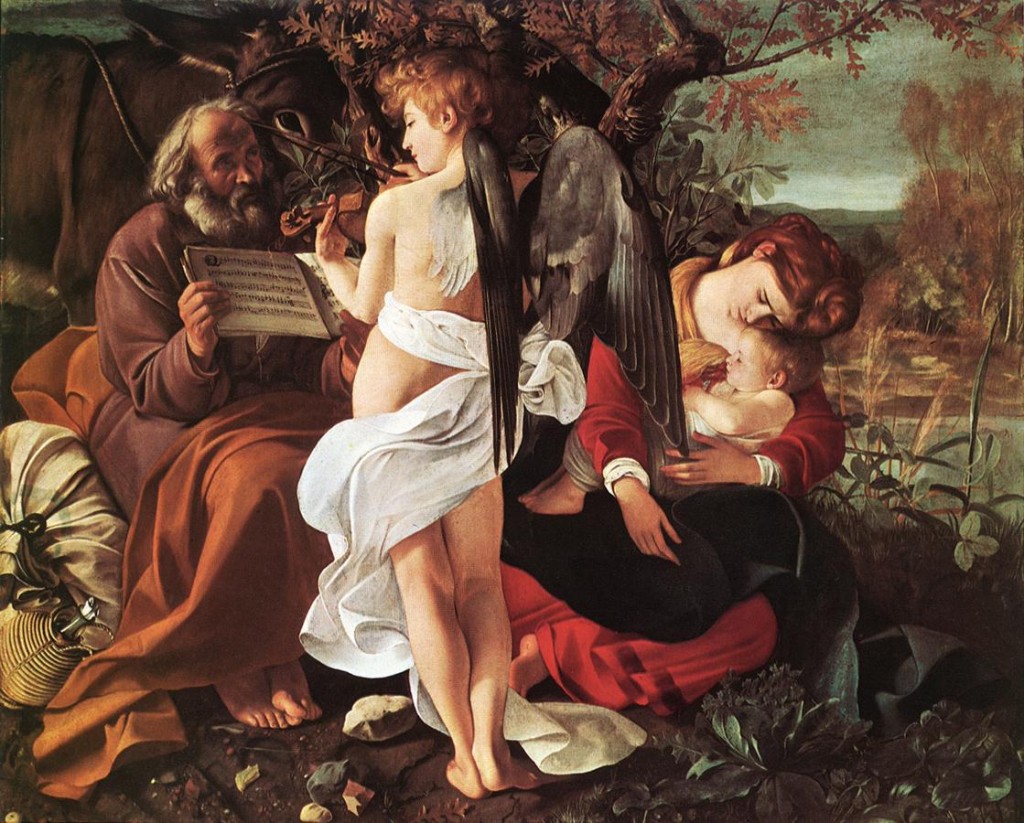
At the Doria Pamphilj gallery, “The Penitent Magdalene” is placed next to another of Caravaggio’s masterpieces “Rest on the Flight to Egypt.” In this painting we see Anna Bianchini portrayed as the Virgin, her beautiful face resting gently on the head of the baby Jesus. Her face is smooth and she appears serene, unlike in the “Penitent Magdalene” whose forehead has worry lines.
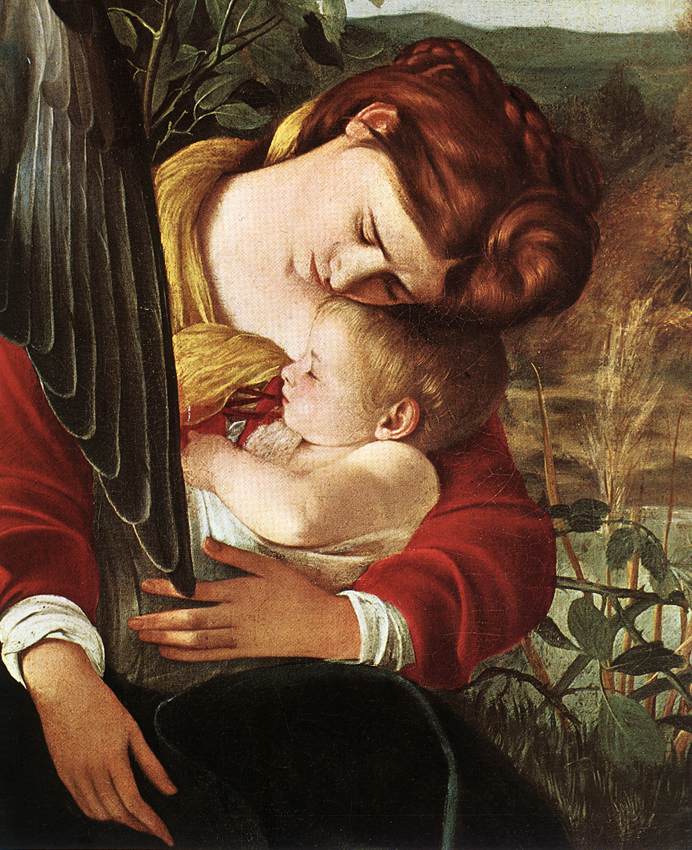
In “Rest of the Flight to Egypt” Anna’s red hair is pulled back from her face, knotted on top and braided. A light falls on her and on an angel who is playing a song on a violin. On the left side of the painting a tired, old-looking Joseph is in the dark. He is holding up a sheet of music for a young boy angel (oddly exposing himself to Joseph–another Caravaggio provocation of the Church?) A donkey with kind, dark eyes peers over Joseph’s shoulder. The donkey understands. The musical notes that Joseph is holding up, apparently is a Renaissance form of music called a Motet and is by a Flemish composer called Noel Bauldwijn. The music is from the “Song of Songs” which referring to the Madonna declares, “how beautiful art thou, and how comely, my dearest, in delights.” Was Caravaggio making a reference to his friend Anna Bianchini?
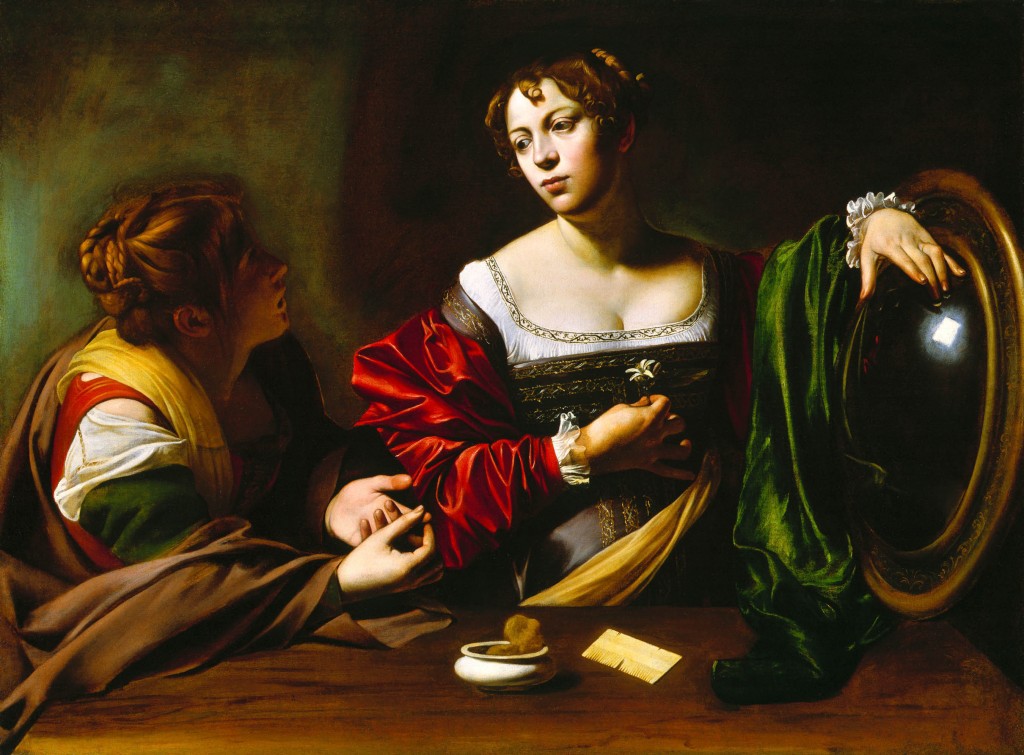
There is another Caravaggio painting where Anna Bianchini appears which I will mention quickly before I get to the tragic conclusion. In 1598 Caravaggio painted “Martha and Mary Magdalene”, now in the Detroit Institute of Arts. In this painting we see Anna and her friend and fellow prostitute Fillide Melandroni who is also in Caravaggio’s “Judith Beheading Holofernes” — (See my blog post “Caravaggio’s Women“). Anna is Martha on the left side of the painting and Fillide is Mary Magdalene on the right. I have not seen this painting in person, but I love its sensual representation of these two women discussing the sacred and profane.
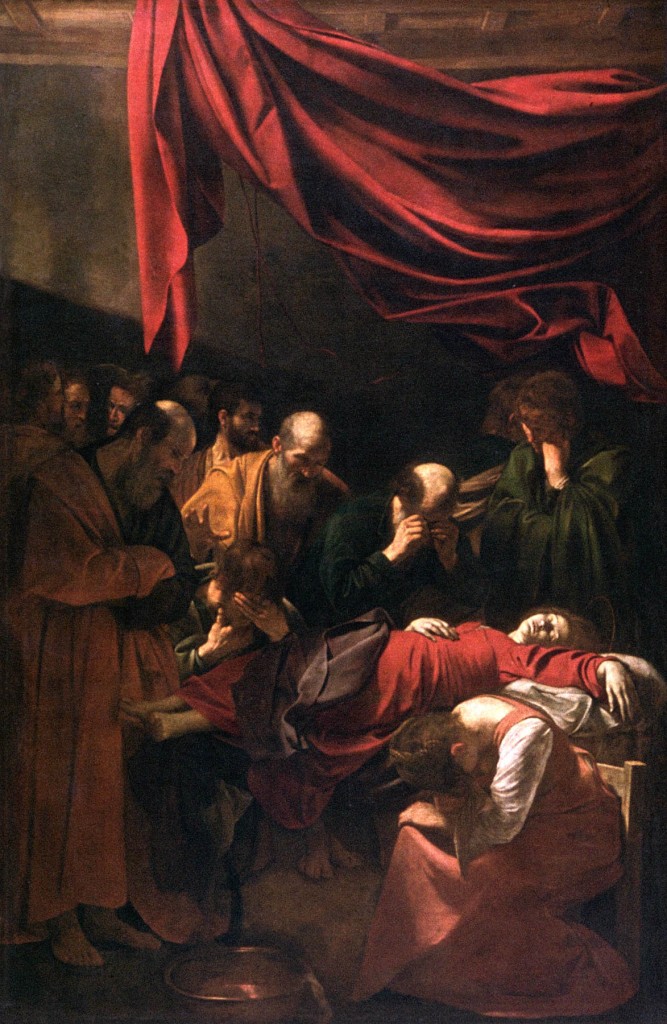
But on to my conclusion. In 1605, Caravaggio painted the “Death of the Virgin” (now in the Louvre) for the church of Santa Maria della Scala in the Trastevere neighborhood of Rome. The painting was removed shortly after it was put up? Why? Because the image was too shocking. The Virgin is splayed out on a table, her bare feet hanging off the end. She has a swollen belly, her dress is open, her face does not look saintly and her arm flops over in an indelicate manner. The only indication of her holiness is the lightly drawn halo over her head. The woman was clearly recognizable as the 24-year-old Anna Bianchini, whose dead body had been dragged out of the Tiber River. Officials said it was suicide, her friends thought she had been murdered.
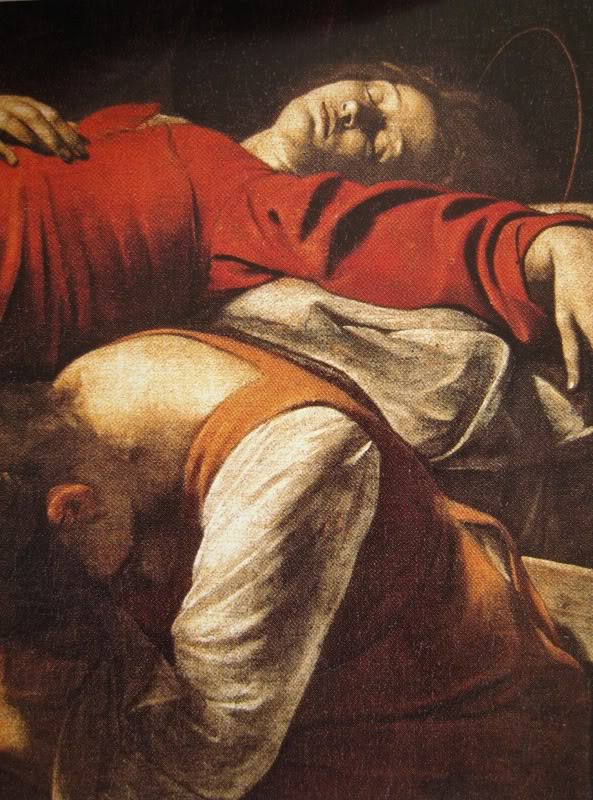
Caravaggio’s contemporary; doctor, writer, art-lover and author Giulio Mancini wrote that Caravaggio had used as his model for the Virgin “qualche meretrice sozza degli Ortacci, qualche sua bagascia, una cortigiana a lui amata.” I will do my best to translate, “Some filthy harlot from the Ortacci, one of his whores, a courtesan that he loved.” (Note: the Ortacci was a neighborhood Rome along the Tiber, near the Mausoleum of the Emperor Augustus, where the prostitutes lived.) That is why I wanted to see Anna’s teardrop. This beautiful woman who suffered, was abused from an early age and yet was also lively and vigorous, this woman who met her death in the most tragic manner, has been summed up for me in the genius of Caravaggio with that simple pearl-drop tear. As I left the Gallery and headed out into the July heat, I walked through the streets of the historic center of Rome, the same streets walked by Anna Bianchini and Caravaggio, and I shed a tear myself for the cruelty of life and the misfortunes of Anna Bianchini.

Trish I am moved by your writing, amazed by your artistic culture and ability to make links. Sweating over my dissertation on a rare London sunny day (obviously not that focused), I miss Rome and can’t wait to go and see that tear on my next visit!
Allegra — You are far too kind to me. To be honest, I am rather ignorant when it comes to art. I think Italians grow up with beautiful art all around them and have a basic understanding of art works that I never got growing up in the US. However, I love looking into the stories of the people behind the art work I like. I have always been fascinated by the extravagant character of Caravaggio, and I was so moved by the story Anna Bianchini. I can appreciate the works more if I know the story behind them…I am less good at recognizing the simple esthetics of a work of art. In fact, at the Gallery Doria Pamphilj in Rome, every inch of every wall has a painting by some famous artist. Looking at it all, I get immediately overwhelmed and can’t appreciate anything. Fortunately, the other day I was just looking for one thing, the tear. Goodluck with your dissertation! I will be thinking of you. I don’t know how you do it with three children!!
Dear Trisha, another great post, thanks so much,
History and art are so much more interesting when we know about the people, not just dates and styles.
Mary Jane
I totally agree Mary Jane and I am glad you liked this post.
I am so happy to read your blogs when they arrive. And even a sad one is one I can devour. This one “hit home” on several levels. I am definitely a fan of Caravaggio’s works and have read an excellent recent biography “Caravaggio A Life Sacred and Profane.” It has many photos of his art work, and I had to keep going back and forth from reading to looking at the photos.
I have also enjoyed several visits to the Gallery Doria Pamphilj and in 2012 even ate lunch in the cafe you mention. The Gallery is certainly on my to-do-again list for when I return to Rome–I hope in late 2015. I have stood and admired Caravaggio’s in the Gallery, but had never heard of the tear drop though I think I have read about the sad model.
I had not “found” you yet in 2011 so after following the link to your story on Caravaggio and Women, I mailed it to myself to read later today. I had already added the website of the young man who does the tour you mentioned to my “Favorites” probably from the story when you described the tour so that, too, is on my list for my return.
I now have one question from early in your story. You mentioned a photo pass. Is that available for the public or only for professional journalists like you? I ask because I am what I guess I consider an “insane photographer” and have 99% of the time used available light for years.
Thanks again for your interesting posts.
Joan
Joan, I am so happy you like this post and I must get that book on Caravaggio to read. As far as the photo pass is concerned, they were selling them to the general public — 4 Euros. It is the first time that I have seen anything like that in a museum and I think it is a fantastic idea. I got stopped by guards both at the Palazzo Barberini and in the Vatican Museums trying to sneak photos for my blog — I think if you don’t use the flash, it doesn’t damage the paintings and so why not sell photo passes to the public. I hope other museums follow their lead.
I’ve actually seen them at several museums, castles, attractions, etc., though of course now I’m struggling to remember which ones. Definitely a good idea!
I think photo passes are a great idea in this era of iphone and instagramming and tweeting and blogging. I am embarrassed to say it, but it even occurred to me to do a selfie with the “Penitent Magdalene” but fortunately I realized that would be extremely tacky and kitsch.
I was also stopped at Palazzo Barberini. I had seen another person taking pictures of that magnificent ceiling so I did too, but I got caught–luckily I already had a couple pictures.
I have taken lots of pictures in the Vatican museums (including picture galleries) and only been stopped in the Sistine Chapel. You must have run into a guard in a bad mood.
It took me a long time to read the Caravaggio book, but I thoroughly enjoyed it.
I absolutely must buy that book this summer when I am in the US. I was looking at Amazon.com reviews after you mentioned it and someone had written that it is a bad idea to get it on a Kindle because you have to be able to flip back and forth to the photos of the paintings. So, I will got to a bookstore and make sure I buy myself a nice copy. Thanks again for suggesting it. When I got stopped at Palazzo Barberini, I was taking a photo of “La Fornarina”. Were you taking a picture of the ceiling by Pietro Da Cortona? Can you believe I live on Via Pietro Da Cortona in Rome and I never knew who he was until I found myself staring up at that incredible ceiling. Hmmmm. Maybe I should to a blog post on him.
Another stunning post. And a deeply moving tale. Caravaggio has managed to give her back in death what was repeatedly torn from her in life, her dignity, and respect for her beauty and her liveliness. And Caravaggio has also endowed the too-often primly portrayed Mary with earthy humanity and love of life, which she must have had, needed to have, and the passion for living, and for loving, for which God was drawn to her, hailing her as full of grace before she was pregnant. Those words from the angel, spoken for God, honor Mary in her own right. And Caravaggio manages to honor both Anna and Mary by having Anna portray Mary in his paintings. Thanks so much for this.
I am so glad you liked this post Nancy. I was thinking of you as I wrote it and wondering what you might have to say about Caravaggio’s choice to use Anna as his model both for Mary Magdalene and the Virgin Mary. I admire you deep knowledge of the bible and the figures in it . I did not discuss the other painting “Martha and Mary Magdalene” but there were a lot of interesting elements in that one too.
Oh Trisha – What a terrific education you have given me about Anna Bianchini and her plight. After seeing you in Rome, we went in search of the painting at the Doria Pamphili. Even though I’ve been in the museum many times, I never really took note of the painting carefully – and certainly never saw the tear, until you mentioned it to me. I was also struck by the pearls and the clothing, which seem far too sumptuous to have been owned by a prostitute. Did Caravaggio have those handy as props – or paint them in from imagination? I was so surprised this year to see the “photo pass” since in the past, photos were never allowed there. Also, now at the Galleria Colonna, which used to be off limits for photos – people were snapping away like crazy when I was there last week (me included). Many more rooms were open to the public too. As one who loves spending hours in art museums, (and taking photographs), I was really heartened by the shift. I can’t understand why some museums are so hard nosed about photography, when they don’t even have an adequate postcard selection for sale of the works in their collection.
Linda, it was wonderful to see you and have a coffee with you at the Caffe’ Doria. I am also glad you were able to appreciate the tear. I don’t know if the clothing and pearls were Caravaggio’s handy props. Good question. What would a normal prostitute have been wearing in Rome at that time? Yes, I am all in favor of the Photo Pass idea, it makes the experience more interactive. Next stop for me Galleria Colonna.
A wonderful story, Trisha, thank you… Art, social history, Caravaggio as a (not so subtle) class critique… perhaps you can popularize it as “The Girl with the Broken Pearl Necklace”… the backstory is certainly fascinating… the book would be super… blockbuster movie rights would follow!!!
What an awesome idea Tom!! Gosh I have so many ideas for books churning around inside me, but this might just have the right combination of the romance, art, sex, violence etc. Hmmn, gotta get working on this one.
Such a sad story! Now I want to run over and see that tear myself. I agree with Tom, it’s a screen play waiting to happen.
Thank you Elizabeth!! I guess I better get going on that screen-play!!
Hi,
Yes, I was taking a picture of Pietro Da Cortona’s ceiling, and did get a couple of good ones.
Please do–do a post on him some time. As far as I remember I only know him in relation to the ceiling.
One disappointment when I have been at Palazzo Barberini (the last two times I think) the room or rooms with Caravaggio were not open. I hear they sometimes close rooms for lack of staff. Sad!
This was a beautiful and an amazing lesson/story on Anna and Caravaggio. Now I cannot wait to get back to Rome and visit this museum to see these paintings.
What a great background on Caravaggio. I saw the retrospective exhibition in a Rome two or three years ago and that was fantastic. I think I found his work more interesting when I read and came to know more about him. Your blog post just underscores how much more interesting some of these paintings become when you understand the painters and the subjects. Noted historian Simon Schama created and narrates a multi-DVD set called “The Power of Art” based on his book of the same name which has episodes on Caravaggio, Bernini, Van Gogh, Rembrandt and a few others which are excellent. The Caravaggio and Bernini episodes are very well done and are very insightful, and to me somewhat heartbreaking. Perhaps sometime in your hectic and full schedule, you might want to check it out, as you may enjoy it. Thanks again for the wonderful read!
Thank you Kay, I must get that DVD. I know nothing about Bernini and he could be a good topic for some future posts too. It is such fun learning about these artists.
finally got to reading this, well done! the “power of art” series is fabulous. tho i didnt like the caravaggio one, made him way too psycho, plus was not shot here, the bernini ep is to die for. you will want to devour everything by and about bernini and borromini afterwards
I am in the US right now on vacation, I am going to run over to the local library right now and see if they have that “power of art” series. thank you!!
Simon Schama’s ‘the power of art’ BBC series is available on you-tube. The episode on Caravaggio, Michelangelo and Bernini are really well done! Ciao, Cristina
Yes, you are not the first person who has told me that. I must buy that series. Thank you!
Dear Trisha, we love the paintings at the doria pamphily’ but could you tell us more about the ceilings there?
Can you tell us anything about the palazzo mattei, what’s the story are behind the walls full of statues, sarcophaguses, busts?
We are from Belgium ‘ we are in rome at december 2014 for the 3 time. Is always as coming home. We thank you if you could answer our question. Two rome-lovers.
Thank you Rita. I am sorry, I cannot give you any more information on what you are asking. I am really not an expert on the Doria Pamphilj Museum, but I am glad you like it and glad you enjoyed my post.
Dear Trisha, I’m currently writing my BA thesis in theology about Martha in the biblical story of the resurrection of Lazarus. I stumbled upon the Caravaggio painting of Mary and Martha and when I googled the model for Martha, I got to your blog post. I enjoyed reading it and getting some more information about the women in the paintings, especially Anna. How fascinating it is that Caravaggio painted her as a virgin, a saint, but also as the alleged prostitute Mary Magdalene, it says that he loved her, but the rest of the world thought that she was trash (the Mancini quote is terribly hurtful!). Thank you for this article (btw. beautifully written, with your personal thoughts and feelings)! All the best to you, Evelyne